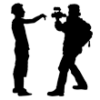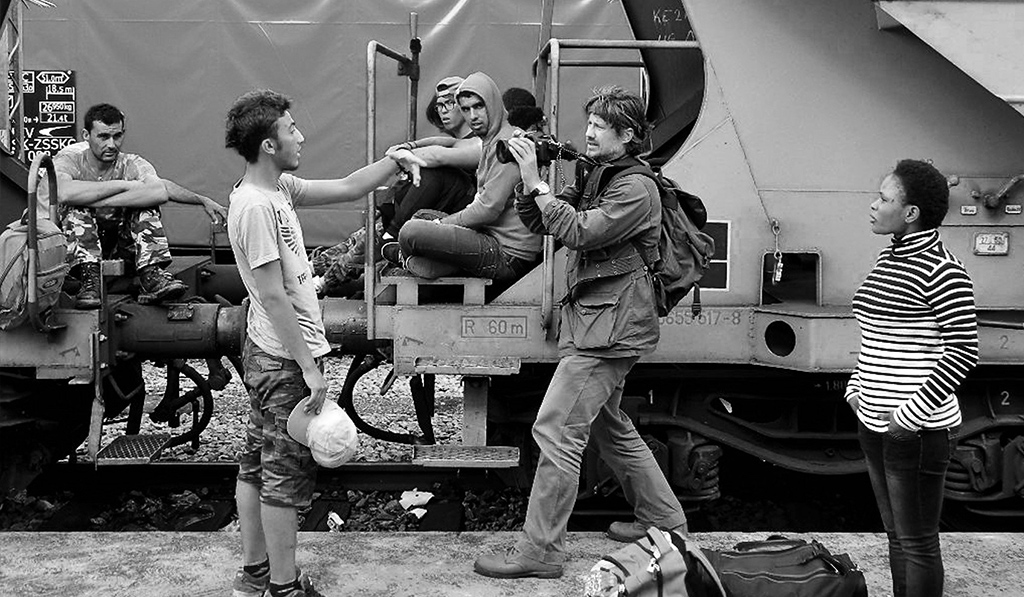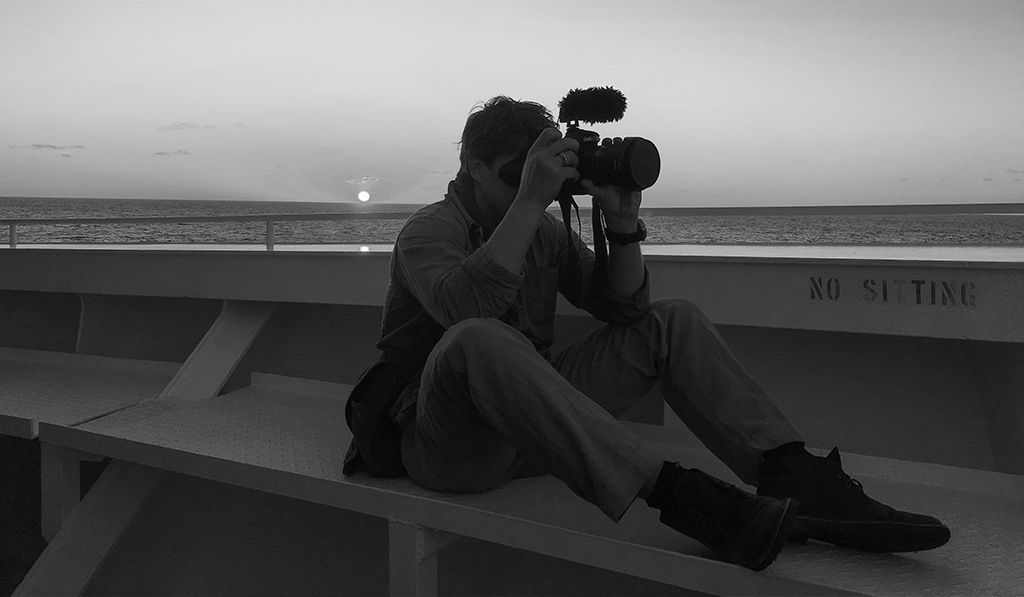

The beginning
Kristian Kiehling: I started to travel at an early age. One of my first memories is sharing a meal aboard the oil tanker my late father captained together with his Filipino crewmen. The tragedies that occur to some people when they are on the move because of their origin made me curious of the contradictory perceptions of human mobility that exist today. One could assume that these contradictory perceptions might be a result of various prejudices that arose in the context of our European history. Following this thought I felt the need to scrutinise some of the racial stereotypes that I had been brought up with. It was these and other aspects of the human condition that made me take up film-making in the first place. I am basically self taught and my experience up to that point was that of a film actor. The only thing I thought I really knew about film-making and about the documentary genre in particular was that reality would always have to be constructed.
the first Steps of the project
KK: I came across an article in the British ‘Guardian’ about an American entrepreneur who had made it his business to rescue people that migrated across the Mediterranean sea.
I wanted to witness the situation first hand and I therefore contacted his organisation and offered to make a film about their work. We eventually agreed on a compromise: I’d get to spend time with them and I would make a series of short films on a voluntary basis for their fundraising purposes. This was how I’ve met Robert Young Pelton – who was then in charge of the media department of the organisation – and Jason Florio’ who was photographing and filming the rescue efforts. In the couple of months we worked together on the island of Malta I was fortunate enough to learn from them as well as to gain insights about the situation in the Mediterranean.
the journey
KK: After finishing my work on the island of Malta’ I invested my savings in film equipment. I then took my car and embarked on a road trip through nine countries along the 2015 refugee trail across Europe. I traveled alone as I had initially thought of making a short film. However’ I soon discovered that this topic needed much more time and so I changed my plans and began to gather material for a documentary feature. Early on I started to realise that I wanted to tell a story which includes the approach to the subject from an European perspective. Another focus soon became the news media. Naturally’ the problem of ‘ talking heads ‘ arose at one point and I tried to counter this imbalance by looking for images that would capture the essence of this journey of peoples from various countries through Europe as well as the historical aspect of the movement of peoples on the old continent.
I discovered that there were questions of true and false narratives on all sides and I endeavored to try to weigh them against each other instead of deciding which was true and which seemed to be false.
finding a balance
KK: When I arrived back in Berlin after two months of filming I had invested nearly all my savings. I was therefore very lucky to encounter editor Eric Pforr and musician Maurizio Curcio – both of whom were passionate enough to care more for the film than for the money.
The post-production was completed in two months and during that time I began to discover the concept of film – time and the possibility to convey a certain shift in perspective by using my material in a certain way. The experiences I had made on this journey were so extreme that I wanted to convey them to my audience formally as well as emotionally. I also came to realise that the social and the political would have to be in balance with the cinematographic aspect. The chorus of different voices I had encountered seemed to demand a certain discord and even an ambiguity by the nature of things. When it comes to music I am generally interested in contrast. Sometimes it is possible to open up new dimensions of a story by using the score to counter the images as opposed to support them.
to what end… ?
KK: Making this film I discovered that my way of telling stories seems to be rather slow and more on the quiet side of things. I was rather a spectator and so I ended up making decisions against some of the conventions of the genre.
I’ve always had a strong affinity to the global film community. I like directors like Michelangelo Frammartino and Andrej Zviagintsev and so it kind of felt natural that the first screening of my film took place in North America and not in my home countries Germany or Latvia.
I also discovered that I have a certain distrust in the spoken word and I think this might be due to my prior education and experiences in the world of acting. Words more than often seem to have limitations when it comes to expressing complex matters that can maybe only be expressed in a formal way – through the use of picture and of sound. I guess, I feel more at home in the language of pictures rather that words. I would like to make a film without words, without language.

The making of “Microcosm”
Kristian Kiehling in his own words
The beginning
Kristian Kiehling: Early in 2016 – while I was still working on the post-production of my first film – I was offered the chance to spend 2 weeks aboard a German holiday cruise liner. This opportunity gave me the possibility to further explore yet another aspect of human mobility. I had read David Foster Wallace’s essay about holidays on a cruise liner and I set myself the goal to film my surroundings from the point of view of a tourist. This also became necessary because I did not have any budget and the legal situation did not allow me to conduct any interviews – even if I had wanted to.
the first Steps of the project
KK: When I embarked on the ship I was confronted with a structure that could be compared to a well oiled machine. Everything works seamlessly from the customers point of view. Naturally’ the perspective from the crews angle is very different. I could not incorporate any details about their work for legal reasons and so I focused instead on tiny details that might help to tell the two sides of the coin. Like in the army’ one could always argue that the crew signed up voluntarily as did the tourists when they booked their trip. What became clear early on though was that those different worlds did not seem to co – exist in harmony. This is what I tried to focus on.
finding a balance
KK: The experience of a tourist aboard such a cruise liner can be likened to the psychological condition of autism – they buy into the concept of an ideal world and they seem to live by this agreement – no matter what happens around them. In the mid of the pacific ocean there can suddenly be stagings of Bavarian beer festivals whilst the maintenance work of the crew is only visible in tiny details in the background. The tourists are whisked away on short tours at the periphery of any which country the ship makes a short landing at and they get a perspective of these places that can only be compared to the reality of a Television commercial. The ships management works hard to convey the experience of being at home while you ‘ re away. I started to film some different impressions of the countries we sailed by and interspersed them with some odd situations of the crew at work in an invisible fashion. I got the impression that the two worlds – the tourists world and the world of the crew – do not really touch and I therefore endeavored to show this disconnection. One of the most memorable moments for me was the discovery of a cooling unit below deck that was in place for the not uncommon event of a death of one of the elderly passengers. This cooler was kept in one of the engine rooms and provided adequate storage for up to 2 corpses. The practicality of this cooler can not be underestimated. Not only can the cruise liner continue its journey’ if death occurs. One could also say that the management sells you a perfect package that reaches even beyond your own death.
to what end…?
KK: I chose to call this short film MICROCOSM because the experience of a holiday cruise in my mind somewhat resembles a microcosm of our society – some people get to do what other people don’t and somehow the cost of luxury is always at the expense of others who are in our sight and yet remain invisible. I wish I could revisit this topic extensively at some point with an actual budget and official clearance in order to be able to dig a little deeper. I am releasing this film not as an official production but rather as a learning experience and an exercise in form.
If anything’ it might just be another innocent tourist video.

The making of “Sebastian”
Kristian Kiehling in his own words
The beginning
Kristian Kiehling: Can it be possible to get to know someone by merely observing his daily life and his work ? To try to find answers to this question I approached a friend of mine who works as a Theater actor in the city of Weimar in the German state of Thuringia. He was just starting to rehearse a monologue – play dealing with the alt – right movement in America by the playwright Neil LaBute. “The Fourth Reich” introduces an American citizen and Holocaust denier who encourages the audience to read Hitlers “Mein Kampf”. Certainly one of the most fascinating aspects of this play is the fact that it actually makes the audience want to read Hitlers “Mein Kampf”. The German IFZ (Institit für Zeitgeschichte) published a thoroughly commented edition early in 2016 and I rented the two massive tomes of 2000 pages to study in pre-production. What struck me was that this document was not only a totalitarian manifest , but that it also detailed precisely what this man would eventually do once he had risen to power. It appeared to me that the reading of such a work without the knowledgeable commentary of scientists and historians might as well deepen any common misconceptions and conspiracy theories that Hitler himself had used at great length in order to establish the myth about his persona and his “Fuehrer” doctrine.
the first Steps of the project
KK: My late German father and his 4 siblings grew up in the surrounding Weimar countryside and I had met my oldest uncle for a bike ride through his home country a year previously. On this trip my uncle had told me how he and his parents had been to Weimar when Hitler was visiting during the’ 3rd Reich’ – regime. My uncle recalled a moment when they all had gathered together with a large crowd on Weimar central square as the masses were shouting : ” Fuehrer, Fuehrer komm hervor aus dem Elephanten Tor “. It is somewhat peculiar that the city of Weimar today does not really display any memorials that would point to its’ 3rd Reich’ – past. Were it not for the enormous Buchenwald concentration camp memorial that sits on the Ettersberg hill some distance away from the city one could think that nothing sinister had ever occurred in Weimar. My uncle and me went there and he recalled that he remembers seeing the searchlights of the watchtowers of the concentration camp in the evenings.
To me , this nowadays invisible historical aspect of the city would have to play a substantial part in the film – not only because of my personal connection to that place through the history of my family , but also because the city of Weimar now seems to focus mainly on its’ palatable past’ – that of Weimar Bauhaus , Nietzsche and of the Weimar classicism. Meanwhile the memory of its’ bad past’ seems to be no matter of greater concern. And most importantly , because my friend the actor was born in the now dissolved German Democratic Republic regime and one of his main concerns as an artist is the surge of the right wing movement in these Parts of Germany in general and especially in the running up to the 2017 parliamentary elections.
the journey
KK: In the run up to the 2017 German parliamentary elections I went to the city of Weimar for a week to film a day in the life of my friend the actor.
I had zero budget for this film and so I was very lucky to secure the cooperation of the Weimar Theater as well as the generous cooperation of the local city archives. The archival footage was elementary as I tried to visualize the research an actor conducts when he works on a play. My friend the actor also allowed me to include some hints about his private life and so the unresolved story of him and his young son soon became a central part of the film. I discovered that the interaction of my friend and me always slightly altered when the camera was rolling. Likewise I found out that it might be next to impossible to convey the inner thoughts and feelings of someone without a distinct dramatic structure of the sort that you can usually only find in fictional films. However, on the other hand I enjoyed the ambiguity of the silent moments with my friend as this seemed to open up numerous possible interpretations of what was going on. Chance would have it for instance that children seemed to be anywhere he went and this helped to contribute to the telling of my friends private story without the use of additional explanation through the use of words.
finding a balance
KK: The fascinating thing about this project for me was to try to use picture and sound to introduce a certain person , his work and the time and place where he lives his current life. Early on I decided to focus on his face and on his voice only while he is working on stage. The decision to focus on his solitude rather than on other aspects of his life also came naturally in connection to the part of his central story that I wanted to emphasize.
to what end… ?
KK: Conspiracy theories are rising in popularity these days and “Brexit” as well as the pivot to the right in U.S. politics serve as good examples for recent shifts in public opinion. In this regard it is particularly worrying that 25 % of the citizens in the Weimar area have recently voted for the’ AFD’ party in the 2017 German parliamentary elections and thus helped 94 of their delegates to gain seats in the German parliament. The AFD is considered to be the first nationalist and openly right wing political party to have entered the German parliament in well over 50 years.